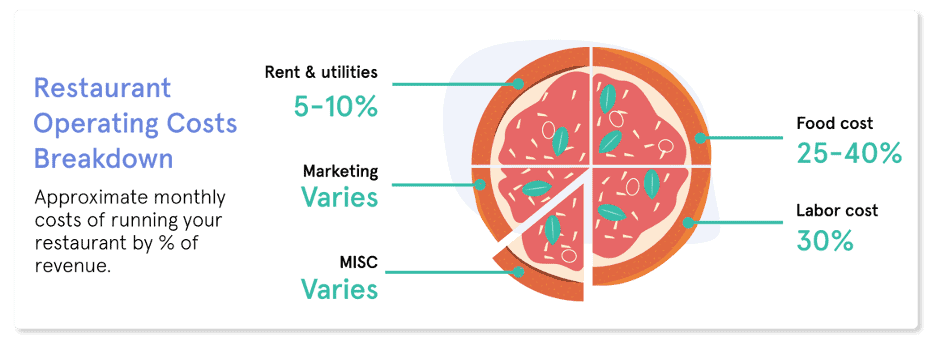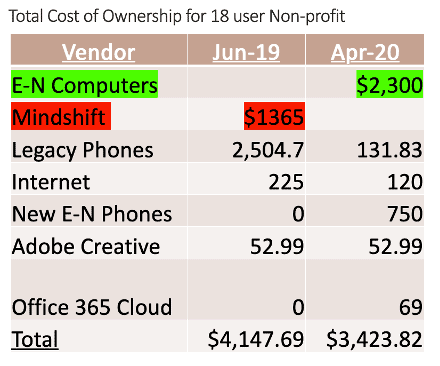

Content Manager, E-N Computers
How much do IT support services cost for a small business? Here at E-N Computers, we’ve answered this question for hundreds of small businesses in Virginia, Maryland, and Washington, D.C. during the 27 years we’ve been in business.
When we start talking with a prospective client, we find that many of them are surprised to learn that they don’t really know how much their IT services are costing them. Many of them are paying an IT vendor or consultant every month, but that represents only a portion of their total IT spend.
Others may be looking to hire a dedicated IT person but aren’t familiar with all of the costs that go into running an IT department. This can make it difficult to compare and price the different IT management options available to you on an apples-to-apples basis.
QUICK ANSWER:
How much do IT support services cost per month?
An all-inclusive managed IT services plan typically costs between $125-$220 per computer-using employee per month. For a typical 40-employee company, this would be about $5,000 per month. Costs can vary within this range depending on existing IT staffing, compliance requirements, and other factors
How does this compare to what you are already paying for IT support? How does it stack up against building your own IT department? And what about standard hourly or retainer contracts for break-fix service – are fully managed IT services cheaper in the long run?
We’ll compare costs for the following IT support options:
- Building an in-house department
- Hiring a break/fix service or contractor
- Using barebones managed IT services
- Using full managed IT services
- Using co-managed IT services (sharing the work between your in-house staff and a managed IT services provider).
The following table provides a quick comparision of various types of IT support and expected costs from highest to lowest, while our article provides a detailed comparison along with some nuances and caveats.
Tech support cost comparison
| Type of IT Support | Cost for 40 employees | What’s not included |
|---|---|---|
| Break/fix Services | $75 to $200 per hour.
Downtime costs businesses an average of $300,000 per hour | Additional costs for hardware refreshes, security audits, and upgrades. Exhorbitant costs associated with downtime or cyberattacks resulting from a lack of preventative maintenance |
| In-house IT Department | $192,600 per year or $402 per user per month | Difficult to find a jack-of-all-trades technician who also has specialized expertise |
| Co-Managed IT Services | $86,000 per year or $180 per user per month (Includes in-house IT person’s salary) | Does not usually include level 1 support if this is performed by the in-house technician |
| Full Managed IT Services | $60,000 per year or $125 per user per month | On-site support visits may incur additional fees |
| Retainer Plus Monitoring | $2,000 per month (includes break-fix hours) or $24,000 a year | Some software or systems may be “out of scope” and billed separately. Limited automation, documentation, and proactive leadership. |
| Retainer Services | $1,500 per month (10 support hours), $175 per hour thereafter. $18,000 base cost per year. | Costs for hardware, security audits, and network upgrades not included. Plans may lack tools or software. |
| Basic Managed IT Services | $17,760 per year or $37 per user per month | He desk support, consulting, remote monitoring, and more available for an additional fee |
IT support costs and pricing: A great business mystery
Most businesses keep track of their recurring operating expenses in great detail. But the same isn’t always true of their IT spend.
For example, a restaurant could tell you down to the penny how much it spends on food as a percentage of total revenue. But how much of their budget was spent on keeping their IT systems running? Servicing their point-of-sale terminals? Fixing the computers used by the administrative staff to order food, design menus, and run payroll?
For most businesses, these expenses are scattered among several different categories and accounts. Internet service may fall under utilities, while purchasing new computers or network upgrades could be either capital or operating expenses, depending on how they’re depreciated or accounted for. This makes it difficult to get an overall picture of IT spend as a fraction of operating costs or percentage of revenue.

The cost of poor IT support services: An even bigger mystery
An even bigger mystery for many businesses is the hard-to-quantify costs associated with relying on inefficient or outdated IT solutions. For example, how much revenue is lost if your warehouse order fulfillment system goes down for an hour? A day? Or how much of your administrative staff’s time is wasted each month searching for files in an outdated document management system?
Increasingly, small businesses are coming to us with overwhelming tech costs – they have subscriptions to multiple cloud services and software – which are eating up their tech budget even without support costs.
Again, these expenses could be hidden in different categories – labor, marketing, operating expenses, and capital expenses could all be increased due to outdated or inefficient technology. These costs can even be lurking in accounts receivable, in the form of longer payment cycles and more overdue invoices and write-offs.
Other costs stemming from poor IT service are easier to quantify, because they come from huge expenditures surrounding an emergency situation – often a cybersecurity incident. Here in Charlottesville, Thomas Jefferson’s Monticello suffered a crippling ransomware attack in 2017 that resulted in the organization essentially rebuilding their network from the ground up. For that, they paid an IT consulting bill of $288,000 on top of their regular IT budget. (We learned this by reading the public financial disclosures all nonprofits are required to file annually.)

Schools, government and smaller businesses are particular targets. In March, the city of Waynesboro had 350 GB of data stolen from its network. In April 2023, hackers intercepted login information from several Virginia state employees as the workers tried to access the state’s human resources and payroll apps on their personal devices.
A recent study found that schools were more likely to be victims of ransomware than any other industry. Experts say this was because they did not put as much time and money toward cybersecurity, and they were more willing to pay a ransom rather than risk exposure of sensitive data about students and employees.
Past Virginia districts that suffered ransomware attacks, phishing attacks or data exposure include Middlesex County, Fairfax County, New Kent County, Albemarle County, Powhatan County and Shenandoah County, just to name some of those nearest to us. How do you calculate the cost to employees and those you serve when you have sensitive personal information like mental health assessments, bullying threats, job evaluations and salaries explosed to the public?
In these cases, failing to pay for IT up front results in higher costs through daily inefficiencies or massive emergency spend later on.
Facing these challenges, you may be ready to step up the quality of your IT support. At that point, the question comes down to should I build or buy an IT department?
How much does it cost to build an IT department?
For many businesses, their first thought is to hire one or more full-time IT specialists to manage their technology resources – in other words, to build an IT department. But how much does it really cost to build a quality IT department? (For a more detailed review of this specific question – and an in-house vs. outsourced IT cost calculator – see our article Should I outsource my IT department?)
The biggest expenditure will likely be salary and benefits. IT salaries vary based on location, experience, skill requirements, etc. But on average, you can expect to pay a general-purpose IT technician around $55,000 to $75,000 per year in total compensation.
IT teams and specialization
That being said, there’s not really any such thing as a “general-purpose IT technician”. Most competent IT people – the kind you’d want to hire – have long since discovered that specialization is the key to a more rewarding job (and a more rewarding salary).
IT engineers tend to focus on a specific area, for example, infrastructure, networking, email, cybersecurity, or client support. And they prefer jobs that allow them to grow and focus on just one or two of those areas. So, it can be extremely difficult to find a “jack-of-all-trades” IT person to support your business.
In addition, a team approach means more resources and more experience available to help with problems when they arise. No one IT person has seen it all, so having others to bounce ideas off of or have another pair of eyes on a problem means faster problem resolutions and better IT outcomes overall.
IT leadership is required
In addition to technical know-how, a quality IT team needs leadership. This includes both day-to-day management, to make sure problems get solved and users are happy, as well as executive leadership to ensure that the IT department is meeting the business needs of the company.
Without good leadership, the IT team can find itself chasing its tail, or constantly implementing “band-aid” solutions without addressing the root causes of recurring problems.
Don’t forget tools and training
Building an IT department involves more than just hiring people to fill roles. Those people need to have tools to use, as well as proven processes for everything from help desk tickets to server upgrades.
To build those processes without reinventing the wheel, many companies engage consultants to help. Consulting fees for IT department processes can range from $1,500 to $3,000 per month. This is what we’ve paid to consultants to help us improve and streamline our processes over the years.
Tools – meaning the software used to manage and monitor the network – are another fixed IT expense. This includes password managers, ticketing systems, security monitoring, antivirus, internet filtering, and other tooling. Costs for these tools can range from $15-$35 per endpoint per month, depending on the number and sophistication of the tools used.
The bottom line: Cost of IT support with your own IT department
How much does it cost to build an IT department? Let’s look at the numbers for a 40-employee company. We’ll stick to the low end of the ranges we discussed – a three-person IT team (IT director, infrastructure engineer, and user support technician) earning an average of $55k each, minimal software and tooling ($20 per user per month), and a $1,500 per month consultant to help with processes and procedures.
This adds up to $192,600 per year for a 40-person company, or $402 per user per month.
Cost of in-house IT support
| Staffing | IT Director Infrastructure Specialist Support Technician | $75,000 $50,000 $50,000 |
|---|---|---|
| Tooling | $20/user/month | $9,600 |
| Consulting | $1,500/month | $18,000 |
| Total per year | $192,600 | |
| Per user per month | $402 |
Of course, most 40-person companies couldn’t imagine spending that much on IT, so they turn to outsourced IT companies and managed service providers (MSPs). How does the cost of hiring an IT vendor compare to hiring in-house staff?
How much does break/fix IT support cost?
Break-fix services refer to the practice of only calling on a professional IT company when something breaks or when an upgrade is needed.
At one time, this was the common solution for solving IT problems, especially for small businesses. You get flexibility, and you’re not stuck with a contract. Up front, it’s ‘cheaper’ because you are only paying for the time to fix a problem, not for ongoing support. Generally, hourly rates for break/fix IT services can range from $75 to $200 or more per hour.
While it may sound like a reasonable approach, it’s not an ideal solution, especially in 2024, because you’re reactively responding to issues rather than actively preventing them in the first place. As mentioned earlier, smaller businesses and not-for-profits are a particular target of hackers, and a single incident of downtime or a cybersecurity breach can wipe out your business.
In a recent survey, the vast majority of small and medium-sized businesses reported their cost of downtime as $300,000 or more per hour.
You can use our cost of downtime calculator to roughly determine your cost risk.
We can’t recommend the break/fix approach, regardless of the up-front cost savings, because of the risk involved and because there are better options for small businesses on a tight budget.
How much do managed IT services cost?
For most companies that have between 10 and 100 employees, hiring an outside company to help with IT makes the most sense – in other words, buying a ready-made IT department. But here too we find a huge range in both costs and quality of service provided by IT vendors.
The biggest difference in upfront costs from IT vendors comes from differences in service models. There are three basic ways that most companies offer IT services: a retainer-based model, a retainer-plus-monitoring model, and a fully managed IT service model.
Cost of retainer IT support services
The first model is a basic retainer model – you pay per month for a fixed block of hours, and then pay a set hourly rate for work in excess of those hours. A 40-person company may pay around $1500 per month for a block of 10 support hours, and then $175 an hour after that.
While this model often appears to be the cheapest option, costs can quickly add up for things like hardware refreshes, security audits, and network upgrades. Or, these projects may be neglected or put off for “when we have more hours” – which tends to never happen. Additionally, these plans rarely include tools or software, which adds additional costs that can be hard to track.
Cost of retainer plus monitoring IT support services
The second IT service model includes some monitoring and tooling, usually for a higher fee (around $2000 per month), as well as a set number of break-fix hours. This offers some improvement over a straight retainer model, but often comes with limitations that end up causing the same problems.
For example, it could be that only some of your software or systems are supported – while anything else is considered “out of scope” and billed at the hourly rate. Again, this results in key projects and upgrades being deferred for a lack of hours or budget, which ultimately results in inefficiencies and emergency spend later on.
Both of these IT service models also suffer from a lack of automation, documentation, and proactive leadership. They tend to result in “band-aid” solutions and workarounds, rather than the strategic IT decisions that need to be made in order for a modern business to thrive.
Cost of our basic managed IT services plan
E-N Computers offers a basic managed services plan for $37 per user that provides at least a minimum level of protection and prevention. We designed this for very small businesses with limited budgets so they can benefit from our economies of scale for services like monitoring and managed antivirus.
If you run into an issue, we have a pre-arranged service level agreement and basic documentation about the business so our help desk can assist at an hourly fixed rate. In other words, you have someone to call who knows who you are.
Our basic plan includes the following:
- Endpoint and network monitoring.
- Windows patching.
- Managed antivirus.
- Helpdesk with service level agreement and hourly fix rate.
Our typical basic managed services plan would cost $17.760 a year for a 40-employee company or $37 a month per user.
Cost of managed IT support services
To address the problems inherent in the retainer-based IT service models, some IT service providers (including E-N Computers) have moved toward an all-inclusive managed IT service model. For a flat per-user or per-computer monthly fee, you’ll receive all of the same services typically provided by a large corporate IT department. This includes help desk service, consulting, remote monitoring and management (RMM), as well as the required tools and software.
A fully managed IT service plan typically costs between $75 and $220 per user or computer per month. This range can be influenced by a number of factors. For example, if you have a formally trained IT person on staff already, the cost would typically fall more toward the $100 end of the scale. Industries that require more advanced security monitoring and compliance, such as defense contractors, would usually end up on the higher end of the scale.
Our typical managed services plan would cost $60,000 a year for a 40-employee company or $125 a month per user.
Cost of co-managed IT support services
Co-managed IT services allows you to have at least one IT person in house and to offload either daily help desk services or higher-level prevention and planning services to a managed IT services provider. You still have the salary cost of at least one in-house IT person but you avoid the cost of hiring more technicians or managers as your business grows.
As mentioned, it’s almost impossible for one IT person to provide all the specialized knowledge required to care for modern IT needs.
With co-managed IT, your in-house staff can get rid of daily work like help desk services so he or she can focus on prevention and planning.
Or, you may want an in-house first-level suppport technician to handle your day to day issues and rely on a managed services provider for specialty knowledge like security, networking, patching, procurement and so forth.
Our co-managed IT services are $75 per user per month. An in-house first level IT support person will cost $45,000 to $65,000.
This adds up to about $86,000 per year for a 40-person company or $180 per user per month, which is almost half the cost of building an entirely in-house team.
Total cost of ownership for IT support services
Not just the check you write to your IT vendor
As we mentioned, a fully managed IT plan can seem more expensive than an hourly or retainer model. But we’ve seen again and again how our customers have saved money every month by making the switch.
In this example, an 18-user Lexington, VA nonprofit organization was paying their old IT vendor $1,365 a month. The ENC managed services plan does run about $1,000 more per month – but they were able to immediately realize savings when E-N Computers retired their very expensive legacy phone system and replaced it with a state-of-the-art VoIP system for a fraction of the monthly cost. Additionally, we were able to cut their internet service bill nearly in half. This resulted in a net savings of over $700 per month or $8500 per year.

Next Actions
- Read the New Horizons Healthcare case study and watch the video.
- Learn more about our managed IT services.
- See our pricing and get an instant quote.
We also have extensive resources on IT hiring and staffing. Here are a few:
READ: How to hire an IT professional
READ: The 29 best interview questions for an IT job candidate
READ: Should I outsource IT services or hire IT staff ? (with calculator)
READ: IT Manager Transition Checklist
Our Learning Center has an entire section devoted to IT hiring and staffing.
Do you know how much you’re paying for IT support? If you’re not sure – or you don’t know if you’re getting value from your IT spend – contact E-N Computers today.
We help organizations with 10-100 employees get their IT spending under control by offering fully managed all-inclusive IT support plans. We are based in Virginia and offer remote IT services from coast to coast.
One organization we were able to make an impact with is Roanoke, VA-based New Horizons Healthcare. To find out how we helped them deliver superior IT service while reducing costs, click here to read the NHH case study or watch the video:
Our managed services plan typically costs around $125 per computer-using employee per month. This includes unlimited help desk support, remote monitoring, consulting, and more.
If you’re not sure if you’re getting good value from your IT support costs, take our free IT Maturity Evaluation. In just 5 minutes, you’ll get actionable insights that will tell you where you can make improvements to your people, processes, and tools. Plus you’ll have the opportunity to book a free strategy call with one of our digital advisors.
Take the IT Maturity Assessment

Is your business ready to weather changes, including employee turnover? Find out by taking our IT maturity assessment.
You’ll get personalized action items that you can use to make improvements right away. Plus, you’ll have the opportunity to book a FREE IT strategy session to get even more insights into your IT needs.

Industries
Locations
Waynesboro, VA
Corporate HQ
215 Fifth St.
Waynesboro, VA 22980
Sales: 540-217-6261
Service: 540-885-3129
Accounting: 540-217-6260
Fax: 703-935-2665
Washington D.C.
1126 11th ST. NW
Suite 603
Washington, DC 20001-4366
Sales: 202-888-2770
Service: 866-692-9082
VA DCJS # 11-6604
Locations
Harrisonburg, VA
45 Newman Ave.
Harrisonburg, VA 22801
Sales: 540-569-3465
Service: 866-692-9082
Richmond, VA
3026A W. Cary St.
Richmond, VA 23221
Sales: 804-729-8835
Service: 866-692-9082
